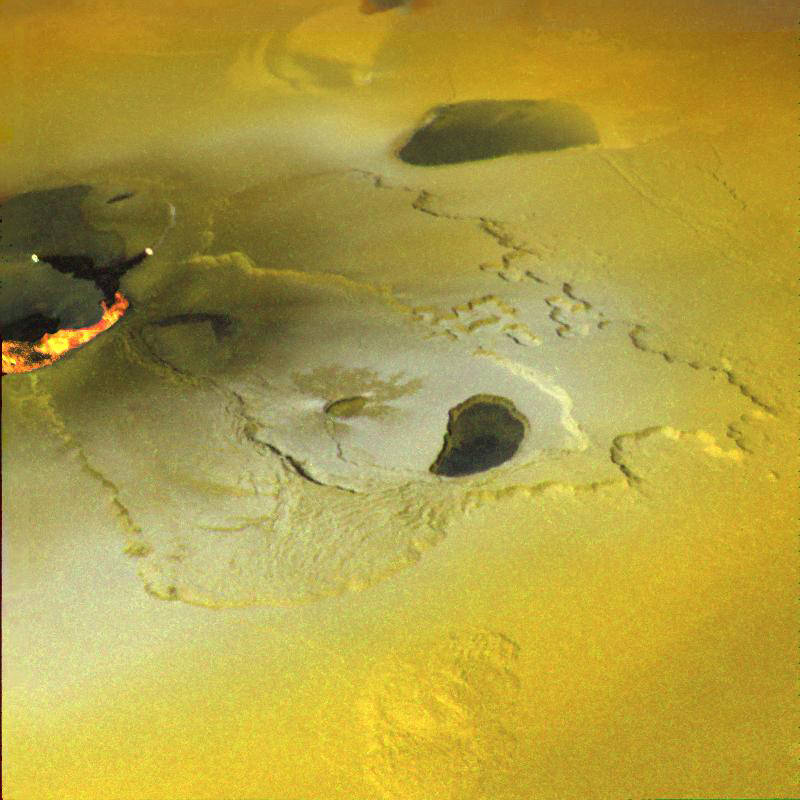Key Concepts
A mountain or hill, generally steep-sided, formed by accumulation of magma (molten rock with associated gas and crystals) erupted through openings or volcanic vents in the Earth's crust; the term volcano also refers to the vent itself. During the evolution of a long-lived volcano, a permanent shift in the locus of principal vent activity can produce a satellitic volcanic accumulation as large as or larger than the parent volcano, in effect forming a new volcano on the flanks of the old (Fig. 1).
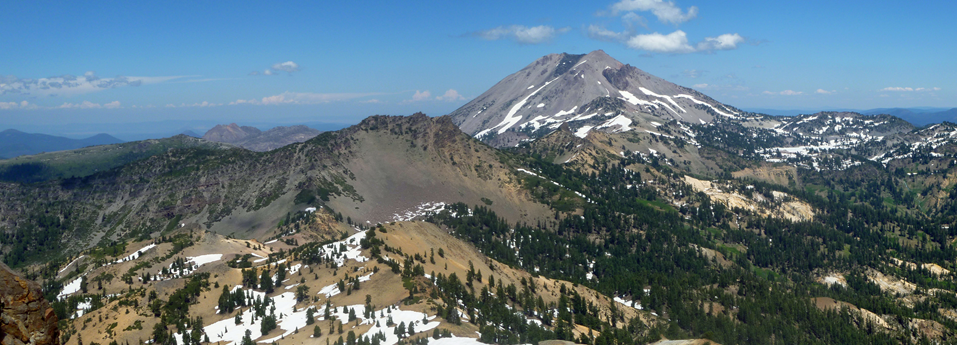
Volcanic vents, channelways for magma to ascend toward the surface, can be grouped into two general types: fissure and central (pipelike). Magma consolidating below the surface in fissures or pipes forms a variety of igneous bodies (Fig. 2), but magma breaking the surface produces fissure or pipe eruptions (Figs. 3 and Fig. 4). Fissures, most of them less than 10 ft (3 m) wide, may form in the summit region of a volcano, on its flanks, or near its base; central vents tend to be restricted to the summit area of a volcano. For some volcanoes or volcanic regions, swarms of fissure vents are clustered in swaths called rift zones. See also: Volcanology
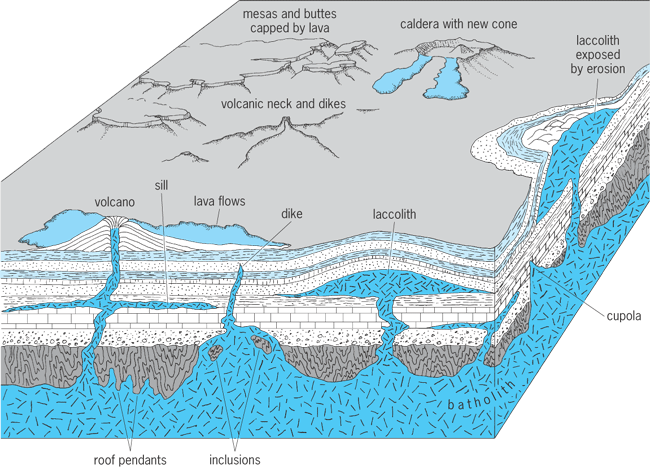
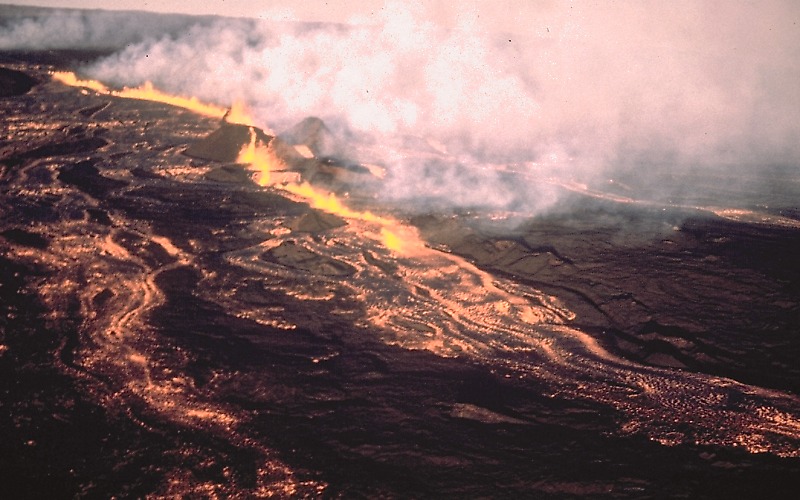
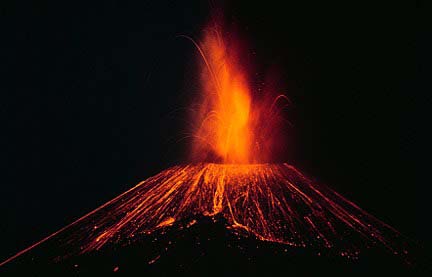
Volcanic products
Magma erupted onto the Earth's surface is called lava. If the lava chills and solidifies quickly, it forms volcanic glass; slower rates of chilling result in greater crystallization before complete solidification. Lava may accrete near the vent to form various minor structures or may pour out in streams called lava flows, which may travel many tens of miles from the vents. During more violent eruption, lava torn into fragments and hurled into the air is called pyroclastic (fire-broken materials). The general term tephra is applied to poorly consolidated pyroclastic debris regardless of fragment or particle size. See also: Crystallization; Lava; Magma; Volcanic glass
The character of a volcanic eruption depends largely on the viscosity of the liquid lava; viscosity, for the purposes of this discussion, can be considered as a stickiness coefficient of the magma or lava. In general, mafic (basaltic and similar) lavas are less viscous (more fluid) than more silicic (dacitic and similar) lavas. Eruptions of mafic lavas commonly are nonexplosive or only weakly explosive and produce mostly lava flows; eruptions of silicic lavas are typically explosive and yield predominantly pyroclastic material. Some produce only pyroclastic material. See also: Basalt; Dacite
Lava flows
Lava flows are classified in terms of their surface characteristics. Flows showing smooth or hummocky, gently undulating surfaces and crusts locally wrinkled into ropelike forms are called pahoehoe. Flows showing very rough, irregular surfaces covered by jagged spinose fragments resembling furnace clinker are called aa (Fig. 5). The terms pahoehoe and aa are of Hawaiian origin. Flows in which the fragments that constitute the upper part of the flow are fairly smooth-sided polygons called block lava. Fluid basaltic and related mafic lavas characteristically form pahoehoe or aa flows, or flows intermediate in character between these two end members. In contrast, more viscous lavas such as andesites more commonly form block lava flows. All lava flows that have poured out on land contain various amounts of open cavities (vesicles), which mark the sites of gas bubbles formed as the rising magma reached regions of increasingly lower pressure before breaching the surface to erupt. Over geologic time, vesicles can be filled by minerals precipitated from circulating mineralizing fluids or ground water. Where pahoehoe flows enter bodies of water or wet ground, they may form heaps of irregular ellipsoids, in cross section somewhat resembling sacks of grain or pillows. Basaltic pillow lavas form an overwhelming bulk of the ocean floor. See also: Andesite
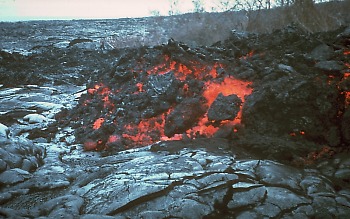
Pyroclastic materials
Magma, at depth and under great pressure, contains gas in solution, but, as it rises into regions of lower pressure near the surface of the Earth, the gas starts to exsolve and escape from the liquid. The gas generally escapes readily from fluid lavas, with little or no explosion; in more viscous liquids, however, the gas may acquire considerable pressure before it escapes and bursts forth in strong explosions. Thus, the emergence at the surface of highly gas-charged, viscous silicic lava may be attended by a sudden frothing as the contained gas rapidly exsolves and vesiculates. The sudden expansion of the gas may tear the froth into countless tiny shreds, each of which chills virtually instantaneously to form fragments of volcanic glass. Continued ebullition of gas results in a mass of small solid or quasisolid fragments, each surrounded by an envelope of still-expanding gas that pushes against all adjacent expanding envelopes. The net effect of this process is the isolation of the solid fragments from contact with one another, and the entire mass obtains an expansive quality that is enhanced further by the expansion of heated air trapped in the hot, moving mass. The result is a very mobile suspension of incandescent solid fragments in gas that may flow—hugging close to the ground—at great speed down slopes and spread out to great distances from the erupting vents, forming extensive deposits having nearly flat surfaces. The denser varieties of such flows are called pyroclastic flows (also ash flows), and their associated lighter-density components are called pyroclastic surges. When such flows come to rest, they commonly are still so hot that the fragments of glass stick together or even merge in the center of the deposit to form a layer of solid black obsidian. The resulting deposits are known as welded tuffs or ignimbrites; the degree of welding of ash flows is largely dependent on the temperature and thickness of the deposit. Rapidly moving incandescent ash flows have been called glowing avalanches or nuée ardentes; they can be highly destructive to life and property. For example, in 1902 a devastating nuée ardente produced during a violent eruption of Mont Pelée (island of Martinique in the Lesser Antilles) virtually destroyed the entire city of St. Pierre, killing some 30,000 persons. More recently, nuée ardentes generated during the March–April 1982 eruption of El Chichón Volcano (State of Chiapas, southeastern Mexico) wiped out all settlements within 5 mi (8 km) of the volcano, resulting in the loss of more than 2000 people (Fig. 6). See also: Ignimbrite; Obsidian; Tuff
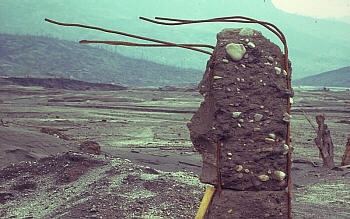
Pyroclastic materials are classified by the nature of the shreds and fragments: essential—the erupting molten lava; accessory—solidified lava of previous eruptions of the same volcano; and accidental—solid material of still older, not necessarily volcanic, rocks from the crust beneath the volcano. The classification of pyroclastic materials also considers size, shape, and consistency of constituent fragments and matrix. Blobs or drops of material still liquid enough to assume rounded or aerodynamically drawn-out forms during flight are known as lapilli (if 0.16–1.2 in. or 4–32 mm in average diameter) and bombs (if greater than 1.2 in. or 32 mm). Depending on their final shapes when they strike the ground, bombs are variously called cow-dung bombs, spindle or fusiform bombs, or ribbon bombs.
Irregular fragments of frothy lava of bomb or lapilli size are called scoria or cinder; if the fragments are sufficiently plastic to flatten or splash as they hit, they are called spatter. The still-molten fragments of spatter often adhere to each other to form welded spatter, or agglutinate. Angular fragments larger than 1.2 in. (32 mm) either solid or too viscous to assume rounded forms during flight are known as blocks; their accumulation forms a volcanic breccia. Ejecta smaller than 0.16 in. (4 mm) are called ash, and those smaller than 0.01 in. (0.25 mm) are called dust. Indurated (hardened) volcanic ash or dust is called tuff.
The term tephra had been applied liberally to all pyroclastic materials, but this term should be reserved, as originally defined, for those pyroclastic deposits of air-fall origin regardless of the size of the ejected material. The individual pyroclastic fragments—the building blocks of pyroclastic rocks—are called pyroclasts. See also: Pyroclast; Pyroclastic rocks
Volcanic gases
In general, water vapor is the most abundant constituent in volcanic gases; the water is mostly of meteoric (atmospheric) origin, but some volcanoes can have a significant magmatic or juvenile component. Excluding water vapor, the most abundant gases are the various species of carbon, sulfur, hydrogen, chlorine, and fluorine (such as CO2, CO, SO2, SO3, H2, H2S, Cl2, F2, HCl). As discussed above, the related processes of rapid exsolution, expansion, and release of gas from the magma as it ascends near the Earth's crust provide the energy for driving and sustaining volcanic eruptions. Volcanic gases, as well as the erupted solid volcanic materials, can pose a hazard to humans. In August 1986, at Lake Nyos, a volcanic lake occupying the crater of a geologically young volcano in Cameroon (western Africa), the sudden overturn of deep lake waters caused the massive release of carbon dioxide (CO2) gas of magmatic origin, asphyxiating more than 1700 people in low-lying areas.
Volcanic aerosols
Violent volcanic explosions may throw dust and aerosols high into the stratosphere, where it may drift across the surface of the globe for many thousands of miles. Fine ash and dust from eruptions of Icelandic volcanoes have fallen in the streets of Moscow. Studies have shown that the particles in the eruption cloud are mostly angular bits of lava, many of them glassy; but some glass spheroids also are present, as well as liquid droplets of hydrous solutions of sulfuric acid and various sulfates and chlorides. Most of the solid particles in the volcanic cloud settle out within a few days, and nearly all settle out within a few weeks, but the gaseous aerosols (principally sulfuric acid droplets) may remain suspended in the stratosphere for several years. Such stratospheric clouds of volcanic aerosols, if sufficiently voluminous and long-lived, can have an impact on global climate. For example, the volcanic cloud from the June 15, 1991, eruption of Mount Pinatubo (Luzon, Philippines)—the world's second largest in the twentieth century—resulted in the lowering of the average surface temperature in the northern hemisphere by about 1°C for nearly two years. See also: Aerosol; Atmospheric chemistry
Volcanic mudflows
Mudflows are common on steep-side volcanoes where poorly indurated or nonwelded pyroclastic material is abundant. They may form by eruptions involving the water of a crater lake; after breaching its confining walls, the water sweeps down the mountainside, incorporating and mixing with loose volcanic debris to form a slurry. Such slurries can be quite dense and commonly have a consistency similar to wet concrete. Mudflows may also form by hot or cold volcanic debris avalanches descending into streams or onto snow or ice. Probably by far the most common cause, however, is simply heavy rain saturating a thick cover of loose unstable pyroclastic material on the steep slope of the volcano, transforming the material into a mobile, water-saturated “mud,” which can rush downslope at a speed as great as 50–55 mi (80–90 km) per hour. Such a dense, fast-moving mass can be highly destructive, sweeping up everything loose in its path. Volcanic mudflows can be hot or cold; they are sometimes called lahars, a term from Indonesia, where they have taken a heavy toll in property and human lives (Fig. 7). Fast-moving mudflows triggered by a small eruption on November 13, 1985, at Nevado del Ruiz, Colombia, killed about 25,000 people. The Ruiz catastrophe was the worst volcanic disaster in the twentieth century since the devastation associated with the eruption of Mont Pelée, Martinique in 1902.
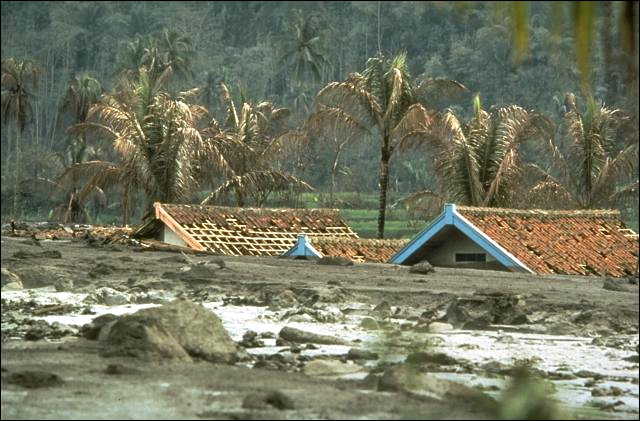
Somewhat related to mudflows are the great floods of water, known in Iceland as Jökulhlaup, that result from rapid melting of ice by volcanic eruption beneath a glacier. A subglacial eruption in October 1996 at Grímsvötn Volcano beneath the Vatnajökull ice sheet, Iceland, produced abundant hyaloclastite. In November 1996, the catastrophic release of impounded melt water from the eruption produced a destructive glacial outburst flood that affected more than 270 mi2 (750 km2) and destroyed or severely damaged several bridges. See also: Glaciology
Volcanic landforms
Much of the Earth's solid surface, on land and below the sea, has been shaped by volcanic activity. Landscape features of volcanic origin may be either positive (constructional) forms, the result of accumulation of volcanic materials, or negative forms, the result of the lack of accumulation or collapse.
Major edifices
The gross form of a volcano is largely determined by the viscosity and mode of eruption of the volcanic products, even though other factors may be operative locally on a smaller scale.
Not all volcanoes show a graceful, symmetrical cone shape, such as that exemplified by Mount Fuji, Japan, or Mayon Volcano, Philippines (Fig. 8). In reality, most volcanoes, especially those near tectonic plate boundaries, are more irregular, although of grossly conical shape. Such volcanoes, called stratovolcanoes or composite volcanoes, typically erupt explosively and are composed dominantly of andesitic, relatively viscous and short lava flows, interlayered with beds of ash and cinder that thin away from the principal vents. Volcanoes constructed primarily of fluid basaltic lava flows, which may spread great distances from the vents, typically are gentle-sloped, broadly upward convex structures that resemble a Germanic warrior's shield in form. Such shield volcanoes, classic examples of which are Mauna Loa and Mauna Kea volcanoes, Hawaii (Fig. 9), tend to form in oceanic intraplate regions and are associated with hot-spot volcanism. The shape and size of a volcano can vary widely between the simple forms of composite and shield volcanoes, depending on magma viscosity, eruptive style (explosive versus nonexplosive), migration of vent locations, duration and complexity of eruptive history, and posteruption modifications (Fig. 10a). Large shield volcanoes are much larger than the largest composite volcanoes (Fig. 10b). See also: Hot spots (geology)
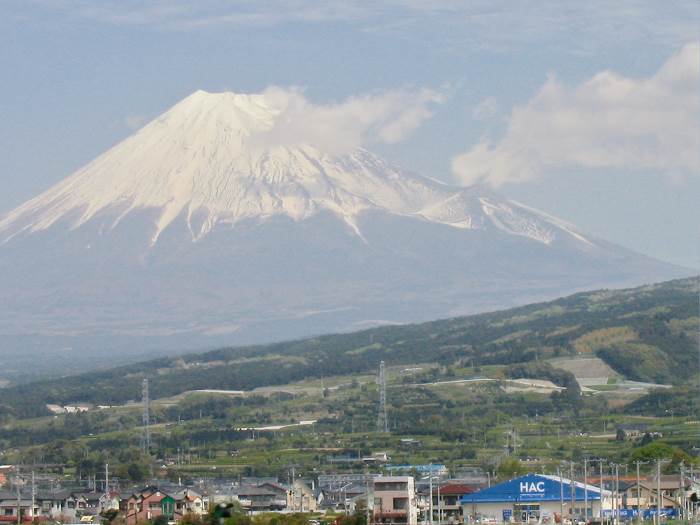
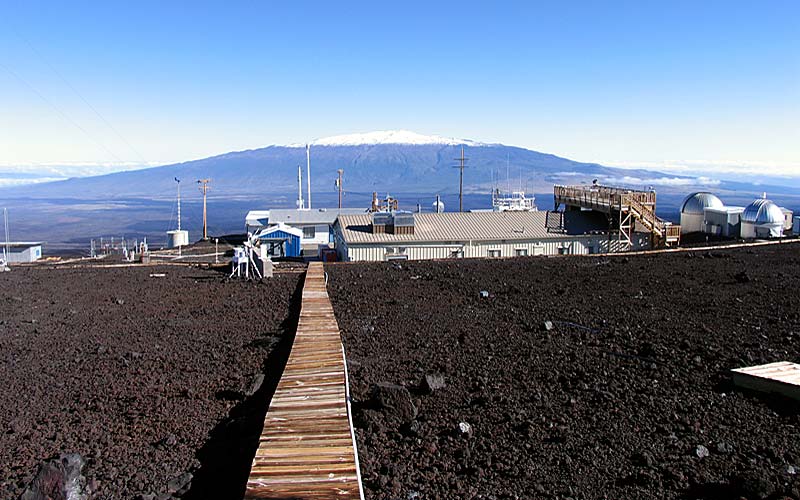
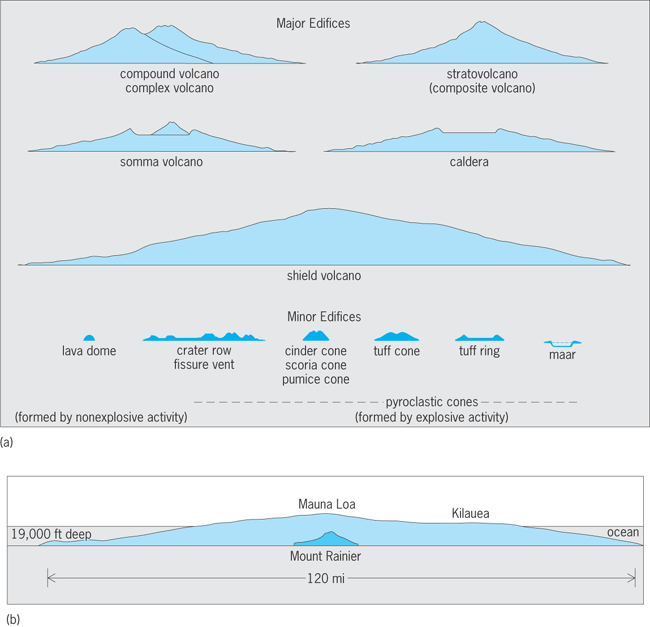
Some of the largest volcanic edifices are not shaped like the composite or shield volcanoes. In certain regions of the world, voluminous extrusions of very fluid basaltic lava from dispersed fissure swarms have built broad, nearly flat-topped accumulations, some covering hundreds of thousands of square miles with volumes of several tens of thousands of cubic miles. These voluminous outpourings of lava are known as flood basalts or plateau basalts. Two examples in the United States are the Columbia River Plateau (Fig. 11) and the Snake River Plain volcanic fields; similar large features exist in India (Deccan Plateau) and South America (Paraná Basin).
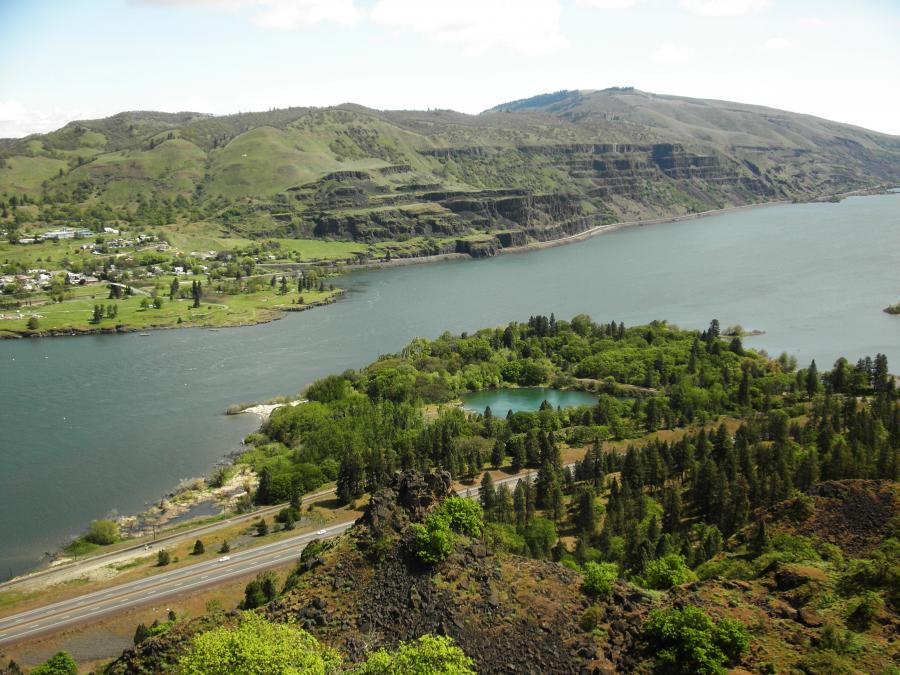
The only volcanic products other than basalt that are sufficiently fluid and voluminous to form extensive volcanic plateaus or plains are ash flows. Some of the larger examples of these ash-flow or ignimbrite plains, such as the central part of North Island of New Zealand, the Jemez Mountains region of New Mexico, and the Yellowstone Plateau of Montana-Wyoming, involve repeated eruptions of ash flows covering many thousands of square miles.
Minor structures
In general, minor volcanic structures originate or develop on or near the major edifice during a single eruptive event or a short span of activity, whereas the major edifices represent the result of repeated activity spanning many thousands or even millions of years.
Lava too viscous to flow readily may accrete in or near the vent to form a steep-sided heap known as a lava or volcanic dome; such domes commonly develop following vigorous explosive activity at composite volcanoes (Fig. 12). Slender spires that thrust through apertures in such a dome are termed spines. The famous spine of Mont Pelée (Martinique, Lesser Antilles), formed during the eruption of 1902, reached a height of more than 1280 ft (390 m), but, like most such spines, was very short-lived. Other near-vent forms that may develop on the volcano include volcanic shield, cinder cone, spatter cone (pipe vent), spatter rampart (fissure vent), ash cone, tuff cone, and tuff ring.
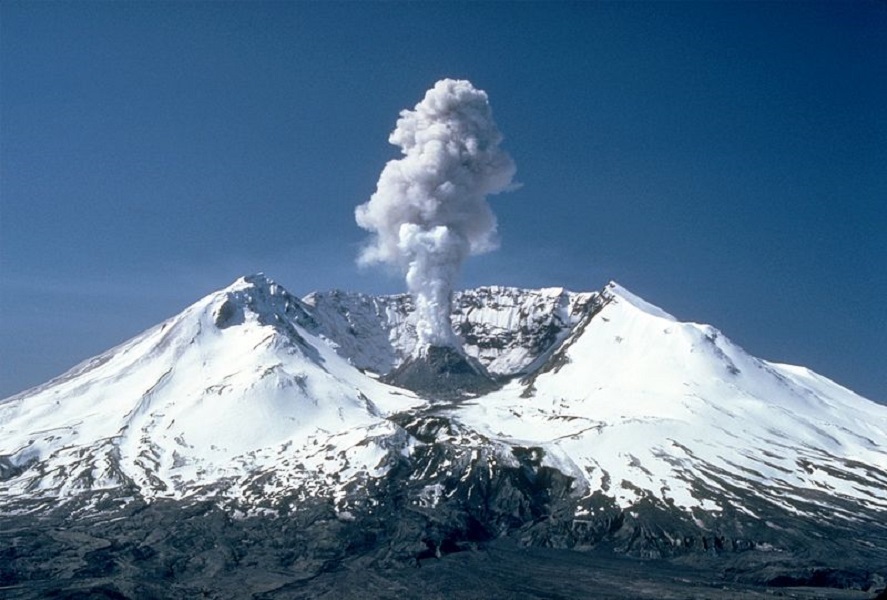
Major edifices are commonly modified by negative or depressional landforms. Small bowl-shaped depressions that are formed by explosion, or by failure of pyroclastic ejecta to accumulate directly above a vent, are known as craters. Most of them are found at the summit or on the flanks of volcanic cones, but some are well away from any cones.
Larger depressions at the summit of volcanoes are formed by collapse of the summit region as the support beneath it is removed by the rapid withdrawal of magma, usually by surface eruption but sometimes by subsurface migration of magma within the volcano. A depression formed by collapse is called a pit or collapse crater, or if larger than about 1.2 mi (2 km) in diameter, a caldera. Perhaps the best-known examples of calderas in the United States are Crater Lake, Oregon; Kilauea Caldera, Hawaii; Yellowstone National Park (Wyoming); and Valles Caldera, Jemez Mountains, New Mexico. Larger, although less regular and obvious, features of similar origin are known as volcanic-tectonic depressions. Like many calderas, their formation commonly, if not always, is associated with the explosive eruption of great volumes of ash flows. See also: Caldera; Igneous rocks; Petrology
Submarine volcanism
More than 80% of the Earth's crust is of volcanic origin, and about three-quarters of all the Earth's active volcanism takes place not on land but deep beneath the oceans. Such deep submarine volcanism occurs along the spreading ridges that zigzag for thousands of miles across the ocean floor, and it is exposed above sea level only in Iceland (Fig. 13). Because of the logistical difficulties in making direct observations posed by the great ocean depths, deep submarine volcanic activity has been rarely—and only recently—observed during actual eruption by scientists. However, ample evidence that deep-sea eruptions are common is clearly indicated by (1) eruption-induced earthquake activity recorded by seismic and acoustic monitoring networks; (2) the presence of high-temperature deep-ocean floor hydrothermal vents called smokers; (3) episodic short-lived but widespread hydrothermal discharges, measured and mapped as thermal and geochemical anomalies in the ocean water above the spreading ridges; and (4) the detection of new lava flows in certain segments of the oceanic ridge system (for example, Juan de Fuca and Gorda ridges off the coast of Oregon and Washington) where there had been none observed previously, as shown by repeated mapping of changes in the bathymetry and imaging of surface features. See also: Hydrothermal vent; Mid-Oceanic Ridge
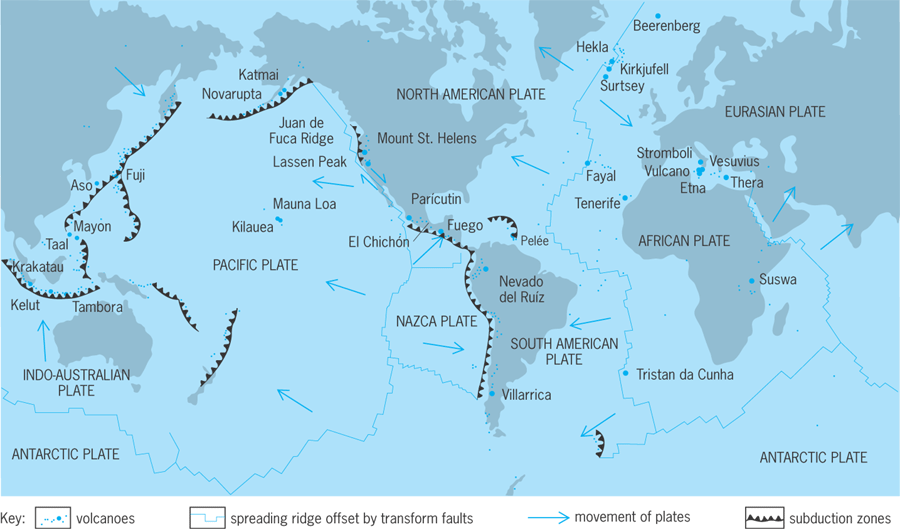
In contrast, shallow submarine volcanism has been directly observed and, in some cases, well studied. Volcanic eruptions in shallow water are very similar in character to those on land but, on average, are probably somewhat more explosive, owing to heating of water and resultant violent generation of supercritical steam. The glassy ash of cones formed in this way commonly is altered, probably by ordinary weathering processes, to brownish palagonite tuff. Such cones, like Diamond Head in Honolulu, usually have broader, flatter profiles than those characteristic of cinder cones.
Much of the ocean basin appears to be floored by basaltic lava, which, judging from its apparent density, is much less vesicular than the lavas of the basaltic cones that rise above it to form most of the oceanic islands. The pressure of the overlying water at great depths in the oceans may prevent the exsolution and explosive escape of gas from erupting lava and greatly reduce the vesiculation of the lava itself. Recent studies of submarine volcanism via deep submersible research vessels and dredged samples show that the volcanic landforms and flow features of basaltic lavas observed on land may be present on the ocean floor in addition to the ubiquitous pillow lavas. Following several months of earthquake activity, at mid-October 2011, a submarine eruption began offshore south of the island of El Hierro (Canary Islands, Spain); this still-continuing activity is building a new volcano on the seafloor. See also: Oceanic islands
Although pyroclastic materials in the ordinary sense seldom form in deep water, lava flows may shatter on contact with the water, forming masses of glassy sand-size fragments resembling ash. Such material, called hyaloclastite, may form in water of any depth and is commonly associated with pillow lavas. Great volumes of hyaloclastite were formed in melt water by eruptions beneath glaciers in Iceland. Like ordinary basaltic ash, hyaloclastite readily alters to palagonite.
Fumaroles and hot springs
Vents at which volcanic gases issue without lava or after the eruption are known as fumaroles. They are found on active volcanoes during and between eruptions and on dormant volcanoes, persisting long after the volcano itself has become inactive. Fumarolic gases include water vapor, sulfur gases, hydrochloric and hydrofluoric acids, carbon dioxide and monoxide, and others in less abundance. They transport and deposit at the surface small amounts of many common metals. Temperatures of the escaping gases may reach 930–1470°F (500–800°C), and the halogen gases and metals generally are found in the high-temperature fumaroles. Lower-temperature fumaroles, in which sulfur gases predominate along with steam, are called solfataras; still cooler ones liberating predominantly carbon gases are called mofettes. Researchers in submarine studies of the East Pacific Rise (20°N, off the mouth of the Gulf of California) and of the Gorda Ridge (43°N, off the coast of Oregon) have photographed undersea fumaroles and sampled metallic sulfides they were emitting.
Fumaroles grade into hot springs and geysers. The water of most, if not all, hot springs is predominantly of meteoric origin and is not water liberated from magma. Some hot springs appear to result simply from water circulating to warm regions at great depths in the Earth's crust, but in many, the heat is of volcanic origin and the water may contain volcanic gases. Indeed, the heat may be derived wholly from rising hot volcanic gases. Some naturally heated water and steam are being developed commercially as geothermal energy to provide electricity or beneficial heat for space heating. See also: Geothermal power; Geyser
Distribution of volcanoes
More than 500 active volcanoes are known on the Earth, mostly along or near the boundaries of the dozen or so lithospheric plates that compose the Earth's solid surface (Fig. 13). These rigid plates, which range in thickness from 30 to 90 mi (50 to 150 km) and consist of both crustal and upper mantle material, form the lithosphere and move relative to one another above a hotter, more plastic zone in the mantle called the asthenosphere. See also: Asthenosphere; Lithosphere; Plate tectonics
Lithospheric plates show three distinct types of boundaries: divergent or spreading margins—adjacent plates are pulling apart; convergent margins (subduction zones)—plates are moving toward each other and one is being destroyed; and transform margins—one plate is sliding horizontally past another. All these types of plate motion are well demonstrated in the Circum-Pacific region in which many active volcanoes form the so-called Ring of Fire (Fig. 13).
Along spreading boundaries, new basaltic magma formed by partial melting of mantle material moves into the tensional fissures, solidifying as dikes or feeding lava flows on the ocean floor, accreting new material to the lithosphere. Volcanism along spreading boundaries is the most voluminous on Earth, but, except in Iceland and the East African rift valleys, where such activity is occurring on land, it has not been directly observed. See also: Rift valley
The Earth has remained more or less constant in size for the past few hundreds of millions of years; thus the accretion of the lithosphere by volcanism at the spreading boundaries must be compensated for by the destruction of lithosphere elsewhere. The compensatory consumption of lithosphere is assumed to take place along the convergent plate boundaries, where one plate plunges beneath (or is subducted by) another plate. Where the plate moves downward in a subduction zone, the lithosphere is depressed, forming deep troughs, such as the Japan and Mariana trenches. As the sinking lithospheric slab enters the hot underlying mantle, it is partially melted, yielding magma that rises through the edge of the overlying plate to produce volcanic activity at the surface. The explosive volcanoes of the Circum-Pacific Ring of Fire, with their predominantly andesitic viscous magmas, have been generated by subduction processes. See also: Plate tectonics; Subduction zones
Some volcanoes, however, are not associated with plate boundaries, and many of these so-called intraplate volcanoes form roughly linear chains in the interior parts of the oceanic plates, for example, the Hawaiian-Emperor, Austral, Society, and Line archipelagoes in the Pacific Basin. Intraplate volcanism also has resulted in voluminous outpourings of fluid lava to form extensive plateau basalts, or of more viscous and siliceous pyroclastic products to form ash flow plains.
Geologic data show that the Hawaiian-Emperor chain becomes progressively younger from northwest to southeast. This relationship, in conjunction with the parallelism in trend of the linear volcanic chain and plate motion, provides the best evidence for the so-called hot-spot or melting-spot model to account for the origin and development of the Hawaiian-Emperor and other linear volcanic chains. According to this model, as the northwest-moving Pacific plate passes over a hot, magma-generating spot in the mantle, the magma formed by partial melting rises through the oceanic lithosphere to form a volcano. This volcano is then gradually and steadily carried northwestward away from the hot spot, until it becomes isolated from the magma-generating source and dies and a new volcano forms behind it over the hot spot. This process continues to form the entire linear volcanic chain. Although most scientists accept the geometric and dynamic aspects of the hot-spot model for the origin of linear intraplate volcanic chains, fundamental questions regarding the origin, persistence, location, or possible migration of hot spots remain. See also: Earth; Marine geology; Pacific islands
Volcanoes on other planets
Planetary exploration has revealed dramatic evidence of volcanoes and their products on extra-terrestrial bodies, such as the Earth's Moon, Mars, Mercury, Venus, and the moons of Jupiter (Fig. 14), Neptune, and Uranus on a scale much more vast than on Earth. For example, Olympus Mons, a gigantic shield volcano on Mars about 600 km (375 mi) in diameter, is larger across than the length of the Hawaiian Islands. However, only the products and landforms of terrestrial volcanic activity are described here. See also: Mars; Mercury (planet); Moon; Neptune; Uranus; Venus
